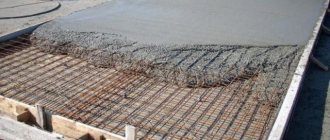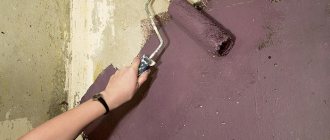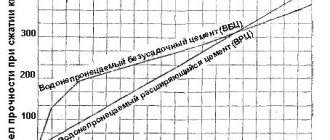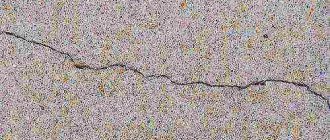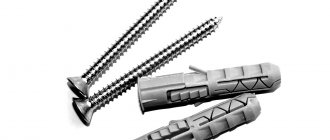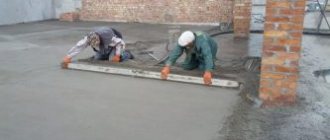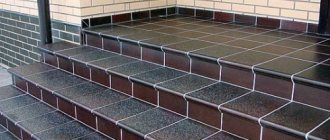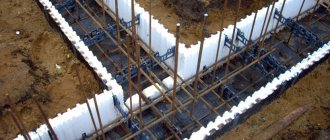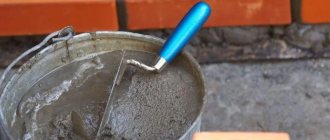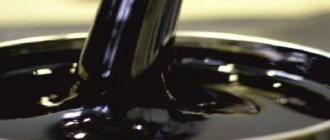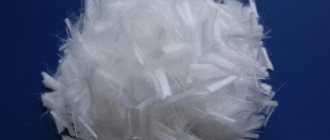Concrete is collapsing and crumbling - what to do?
Concrete is a building material that is obtained by mixing sand, cement, crushed stone and water and, if necessary, can have special additives to increase the strength of the solution.
Concrete has many advantages: frost resistance, water resistance, high strength and longevity. Various building elements are made from concrete mortar, buildings and structures are erected. But, like any building material, concrete is subject to deformation, in particular, crumbling. Why do concrete structures collapse and what to do if the concrete crumbles? Such questions are asked by property owners whose concrete mortar has crumbled, then they look for possible ways to eliminate the problem and prevent its further formation.
Despite the strength of concrete, it is susceptible to destruction due to the influence of the following factors:
- Moisture that penetrates the pores of the solution during periods of negative temperatures expands, forming enlarged voids. When the air temperature rises, the pore volume decreases, which leads to the filling of the resulting voids with moisture. As a result, cracks form between the voids and the concrete surface is destroyed.
- Temperature changes. To prevent the concrete composition from deteriorating under the influence of temperature changes, the poured surface is protected with insulating material or frost-resistant mortar.
Concrete crumbles due to the following reasons:
- At the stage of pouring the structure, a low-quality solution was used. This could be caused by bad cement or an incorrectly taken part of it for preparing the concrete mixture. But this is an unlikely reason.
- The main cause of deformation in concrete is water. The concrete mixture perfectly absorbs water, which at sub-zero temperatures freezes and expands in volume, filling the pores. When the temperature rises, the water thaws and space is made in the pores for new liquid. The process is repeated and ultimately leads to destruction of concrete structures.
- During the preparation of the working mixture, a large amount of water was taken. Excessive presence of water reduces the strength of the concrete surface.
- Improper care of building materials at the time of work. After pouring the working mixture, it should be irrigated with water for the first three days. When pouring the solution into the formwork, it must be thoroughly compacted, then the structure of the mixture will become homogeneous and the porosity of the concrete will decrease.
To prevent concrete from crumbling during operation, adhere to the following recommendations:
- when making a concrete solution, special additives are added to it that can repel water;
- plasticizers are included in the mixture, which will provide the solution with a uniform structure and increase strength;
- the already poured solution is impregnated with a hydrophobic composition;
- be sure to impregnate the surface of the poured solution with water-repellent agents in the hot season, without using special equipment;
- with constant humidity of the structure, the surface is impregnated under pressure using special equipment;
- It is important to ensure proper care of the poured surface and not to exploit the structure ahead of time; the concrete solution gains its strength characteristics 28 days after installation.
Foundation repair.
It is important to pay attention in time to the fact that the foundations of buildings and structures have begun to crumble. Having noticed the first signs of deformation of the foundation, you should not delay repairs, otherwise in the future it will take much more money and time to restore it. Failure to correct the problem in a timely manner will result in the destruction of the walls.
- The finishing material is peeling off. This can happen if poor quality materials were chosen for the construction of the foundation.
- Cracks on the foundation and entire surface of the house may indicate subsidence of the building and its uneven settling.
- Basement humidity.
- The horizontal level of the floor was broken. This defect makes it clear that the foundation of the house has begun to deform.
- The soil level has changed.
Before starting repair work to restore the foundation, the causes of the damage are identified, the type of which will determine how to eliminate the problem. Once the causes of foundation deformations have been identified, repairs begin. A complete replacement of the foundation of buildings is required in case of complete destruction of the foundation with violation of the structure of the walls. The first step is to replace the structural elements that bear the heaviest load.
The process of restoring a destroyed base includes stage-by-stage casting with reinforcement. This method will increase the strength of the new foundation. Step-by-step casting is performed in cases where it is impossible to save the damaged foundation; in all other cases there is no need to resort to such a complex method. It will be enough to simply fill the missing piece of the foundation and attach it to the base.
To prevent the foundation from collapsing in the future, you need to constantly inspect the sides of buildings and carry out regular competent maintenance of them. Maintenance includes thermal protection of the foundation and prevention of flooding.
Conclusion
Concrete is a durable building material with a service life of hundreds of years. However, nothing lasts forever! Concrete is also subject to various deformations, in particular crumbling. To prevent concrete crumbling, you should determine the cause of the defect and only then begin to restore the foundation of the buildings.
But it will be even better if the concrete composition does not crumble at all; for this you need to carry out preventive methods aimed at maintaining the strength of the concrete.
: Concrete, being a durable “stone” building material, is nevertheless susceptible to destruction: cracking and crumbling. There are several objective reasons for the destruction of concrete, which will be discussed in this article.
As already mentioned, specialists in the field of construction technologies have systematized and described all possible causes of cracking and crumbling of concrete structures and reinforced concrete products:
- Water penetrating into the pores and cracks of the material. From a high school physics course, we know that water is a unique substance that can be in three states of aggregation: steam, liquid and ice. At the same time, when water freezes, its volume increases. It is this property that causes concrete to crumble - water frozen in winter literally “tears” the concrete into pieces;
- Significant seasonal or technological changes in ambient temperature;
- Concrete of inadequate quality was used when pouring the structure. Reasons for poor quality concrete: stale cement or poor proportions of cement and mixer (water);
- In the process of preparing concrete, its mobility and workability were achieved not through special additives, but through the excessive addition of a mixer;
- Inappropriate care of the concrete structure during the period of setting, strengthening and hardening. As you know, a freshly poured structure in the summer must be regularly sprayed with water and covered with plastic film, and in the winter it must be heated with special mats, a heating cable and other known methods.
Considering that almost nothing can be done about crumbling concrete, it is easier and cheaper to prevent an unpleasant situation in the following ways:
- When preparing concrete, special additives should be used to give the final product water-repellent properties;
- Special plasticizers are added to concrete to reduce pore formation and increase strength and density;
- The poured structure is impregnated with a hydrophobic composition;
- Treat the surface of freshly poured and old concrete with water-repellent primers;
- Use exclusively fresh cement of the required grade, do not violate the proportions of the components and carefully care for the concrete product for 14-28 days;
- If possible, insulate external surfaces in one way or another.
In this case, you have few options. Having seen the first “symptoms” of destruction, you should immediately begin repairs. First of all, the causes of destruction are determined.
If this is moisture penetration, a complex of works is carried out: the surface is thoroughly cleaned of amorphous masses, the resulting cavities are covered with “strong” cement mortar and, after hardening, they are treated with a deeply penetrating primer. Small cracks are rubbed with cement-sand mortar, and large cracks are filled with special repair compounds.
More extensive destruction of load-bearing structures will require dismantling of the structure and refilling. It is possible to use step-by-step casting of damaged parts with reinforcement binding. The possibility and technology of such repairs are determined by qualified specialists in each competitive case.
To summarize, it is worth once again focusing the attention of “thrifty” developers on the fact that saving on the quality and quantity of building materials subsequently results in huge costs for the repair of buildings and structures. Moreover, the amount of these costs is always significantly higher than the amount of illusory savings on strict adherence to the proportions of components and the stages of filling and maintenance technology.
How to prevent concrete crumbling?
To prevent concrete from crumbling during operation, adhere to the following recommendations:
- when making a concrete solution, special additives are added to it that can repel water;
- plasticizers are included in the mixture, which will provide the solution with a uniform structure and increase strength;
- the already poured solution is impregnated with a hydrophobic composition;
- be sure to impregnate the surface of the poured solution with water-repellent agents in the hot season, without using special equipment;
- with constant humidity of the structure, the surface is impregnated under pressure using special equipment;
- It is important to ensure proper care of the poured surface and not to exploit the structure ahead of time; the concrete solution gains its strength characteristics 28 days after installation.
Basic ways to strengthen a concrete floor
Strengthening concrete floors prevents their further destruction and returns them to their previous performance properties. There are different technologies for strengthening concrete. The specific method is chosen depending on the condition and age of the floor.
Currently, to strengthen a concrete floor, the following are most often used:
- grinding;
- topping;
- special impregnations.
If the concrete screed is made with the addition of granite or marble chips, then after grinding the floor will also acquire a beautiful, textured pattern.
Topping is a relatively simple and economical technology that allows you to obtain highly durable, dust-free floors. After applying the topping, the concrete surface becomes 5 times more wear-resistant and 2-4 times more impact-resistant. Floors with topping are recommended for use in production shops where heavy loading equipment operates, in shopping malls, garages and parking lots. But such floors are not suitable for rooms where chemical spills are possible.
For rooms with high humidity, special impregnations that compact the structure of concrete are more suitable. They penetrate deep into the concrete, creating the effect of sealing and densifying the material. Impregnations are widely used to strengthen old and weak screeds, as they can increase their strength and resistance to abrasive loads several times.
Concrete floors can be found not only in production workshops, but also in public buildings, garages, basements and home workshops. Most owners wonder why concrete floors get dusty? And not everyone knows how to get rid of this trouble. On the one hand, the concrete coating is reliable, but on the other hand, sooner or later cracks, chips, and delaminations begin to appear on the unprotected layer. And if you do not take steps to protect the concrete floor in advance, dust will appear, which is destructive and unsafe for human health.
The top layer of the concrete floor takes on many loads associated with its operation. As a result of mechanical and chemical influences, the coating is gradually damaged and cement dust appears. This process occurs for the following reasons:
- due to non-compliance with installation technology;
- due to incorrect composition of the concrete solution;
- due to poor quality components.
But even the strongest concrete floor, without hardening or treatment, is susceptible to the effects of abrasives that fall on it, as a result of which the surface wears out, loses strength and dust appears.
The solution may contain cement, which did not have time to react with water during the preparation of the concrete mixture. It remains in the porous structure of the material as dust, penetrating from time to time into the surrounding space.
Low quality concrete breaks down on its own. And corrosion processes, which also lead to the formation of dust, can occur for various reasons. For example, carbon dioxide reacts with lime in concrete. As a result, microcalcite appears - the same fine dust.
Dust removal of the floor
Protect concrete floors using special impregnations, primers and coloring compounds. The surface acquires:
- antistatic;
- hygiene;
- anti-slip qualities;
- completeness (no chips or other defects);
- strength;
- durability;
- aesthetics.
Currently, there is no need to puzzle over how to treat concrete floors. Manufacturers offer a wide selection of coloring, impregnating and priming compositions:
- acrylic;
- alkyd;
- epoxy;
- polyurethane.
In addition, a dry mixture called topping is used for strengthening, and home craftsmen recommend coating the concrete floor in utility rooms with PVA glue diluted with water in a ratio of 7:1 or 10:1.
Each option has its own characteristics, application technology and expected end result.
At the initial stage, the top layer of concrete is cleaned of debris, oil stains, peeled and chipped areas. Then the holes and cracks that appear are sealed, after which grinding is performed. Its task is to level the base and improve adhesion to impregnating and painting compounds.
After finishing grinding work, it is imperative to remove cement dust.
To do this, it is recommended to use an industrial vacuum cleaner, which can be rented from a specialized company, as well as a grinding machine. For a small amount of work, an ordinary broom, a household vacuum cleaner and a mop with a damp cloth will be sufficient.
How to fix a concrete path at your dacha?
The fact is that when we filled these paths, we made one unfortunate mistake. First they poured something like a base coating. Then, after the concrete had completely dried, they poured a thin layer of cement on the upper part of the path so that the surface was smooth, if I’m not mistaken, this operation is called ironing by specialists. In the first summer everything was great, the resulting paths could even be washed with a rag, but when the snow melted after winter, we were shocked.
The entire surface was covered with a network of small cracks, which began to turn into holes in the summer. Now the surface continues to crack and shed the top layer of concrete like a molting skin. I have no idea what to do. The idea came to mind to try to repair the top layer using tile adhesive, because in theory it has quite strong adhesion to the surface, has anyone had a similar experience? Or maybe there are other ideas for repairs?
Concrete grinding
The surface layer of a concrete floor is not very durable, so when it is exposed to mechanical loads, changes in temperature and humidity, it begins to crumble, which leads to a reduction in the life of the floor. In addition, the process of concrete maturation is always accompanied by the release of cement laitance to the surface.
When hardened, this milk forms an extremely fragile layer, which often becomes the main source of the formation of cement dust. To prevent dust formation, it is necessary to remove the top weak layer of concrete and expose a stronger surface. To do this, grind the concrete floor.
Sanded floors have a number of positive qualities:
- high strength and wear resistance. Floors after sanding can withstand any increased loads well;
- chemical inertness. Sanded floors become resistant to various technical liquids and chemical solutions;
- dust-free, hygienic. After grinding, a concrete floor stops generating dust, making it easier to maintain;
- decorativeness. After grinding and subsequent polishing, concrete floors become aesthetically attractive and can be used not only in industrial areas, but also in residential areas.
There are different technologies for installing polished concrete pavement, so they can consist of a different number of stages. The number of these stages depends on many factors, including the initial state of the concrete floor, the conditions for this process, and the type of tool used.
In any case, the process includes the following main steps:
- preparatory work. At this stage, the concrete base is cleared of debris and dust. If there is any floor covering, it must be dismantled and the surface leveled as much as possible. Next, you should repair all existing cracks and chips;
- After the preparatory work, rough grinding of the concrete surface is performed. To do this, use a diamond tool with a grain size of 80 Grit;
- after rough grinding, impregnation is applied to the concrete to harden its surface;
- After the impregnation has dried, finish grinding is performed using a tool with a grain size of 150 to 400 Grit.
- The next step is polishing the floor. Its surface is brought to perfection by successive applications of fine-grained tools, starting from 1000 to 3000 Grit;
- After polishing, the floor surface is cleaned of dust and covered with several layers of polyurethane varnish.
Grinding can act as an independent procedure for strengthening a concrete floor or as a preparatory step before applying reinforcing compounds, since it increases the adhesion of the concrete surface to any building mixtures and solutions.
Sanding is used for both freshly laid floors and old substrates.
The first pass on a freshly laid floor is made no earlier than 6-7 days after pouring the concrete mixture. This is necessary in order to remove the layer of cement laitance and open a more durable layer for better ripening. Final grinding is performed no earlier than a month later, that is, after the concrete has fully matured.
Before grinding an old concrete base, its readiness for this procedure is first assessed. “Weak” areas - looseness, peeling, crumbling - are unacceptable. If such defects are present, it is necessary to carry out repair work using epoxy compounds.
If the damage covers more than 30% of the floor area, a new screed is poured.
DOMOSTROYPlumbing and construction
- Thursday, December 12, 2020 1:03
- Comment
Author: Sereg985
- Category: Construction
- Link to post
- https://firmmy.ru/
: Concrete, being a durable “stone” building material, is nevertheless susceptible to destruction: cracking and crumbling. There are several objective reasons for the destruction of concrete, which will be discussed in this article.
Basic ways to strengthen a concrete floor
During operation, the concrete floor in the garage is subject to mechanical damage. Chips and cracks appear on its surface.
Chemical components gradually destroy its structure. You can protect your concrete floor by painting it.
In this article we will talk about how to paint a concrete floor in a garage to avoid dust and how to choose concrete paint for a garage floor.
First, you need to find out the cause of the problem, which will allow you to choose the most effective repair method. If you ignore this step, the efforts spent on eliminating crumbling will be in vain.
The main factors influencing base shedding are:
- Failure to comply with technology when constructing the foundation. The choice of low-quality building materials, insufficient laying depth, errors made in calculations and design have a very detrimental effect on the condition of the finished foundation;
- Selecting the wrong type of base. An incorrectly selected design will have low load-bearing capacity and will not be able to support the weight of the structure;
- Uneven shrinkage of the house. To avoid dangerous consequences, you should carefully care for the base. A suitable solution would be to increase the area of the base with a strong attachment to the old foundation;
- Unstable soil on the site. One of the most common causes of destruction of the basis, which is impossible to eliminate. The solution will be to additionally strengthen the foundation and walls of the building;
- The use of low quality waterproofing during foundation construction. In this situation, the structure will suffer from soil and sediment water, seasonal flooding (which is why very often the foundation crumbles after winter). To protect the structure, care must be taken to create a system for draining water from the foundation;
- Redevelopment of the building. Such manipulation leads to a displacement or increase in the load transmitted to the foundation. Because of this, the parts that are subjected to the greatest load begin to crumble.
Concrete impregnations are one of the most common ways to strengthen concrete floors. They are a liquid composition on an organic or inorganic basis. Inorganic impregnations are called fluates. After application, they enter into a chemical reaction with the components of concrete. As a result of this reaction, a durable protective film of chemically inactive compounds is formed on the concrete surface.
Organic (polymer) impregnations are considered a more effective material for strengthening concrete. When using them, the pores of the top layer of concrete are filled with polymer, so it is modified into a concrete polymer with improved strength characteristics. Moreover, the degree of strength obtained will largely depend on how deeply the polymer composition has penetrated into the concrete thickness.
Unlike topping, impregnations should be applied to concrete no earlier than 10-15 days after it is poured. Before applying the impregnation, the floor surface must be thoroughly cleaned and sanded to remove the layer of cement laitance.
All strengthening impregnations available today are divided into:
- impregnating compositions-fluates;
- polyurethane;
- deep penetration.
At the moment, the most popular are polyurethane impregnations. The high demand for impregnations of this type is explained by the fact that they allow not only to strengthen concrete, but also to create additional tightness, protection from dust, and increase immunity to temperature changes and various chemicals. The depth of the reinforcing layer reaches about 3 mm.
The main limitation on the use of polyurethane impregnation is the moisture content of concrete: it should be no more than 5%.
In cases where it is necessary to strengthen the concrete coating as much as possible, deep penetration impregnations are used. These compositions give concrete floors technical characteristics identical to those they acquire with the help of materials of the first group, but only the latter can be used in rooms with high humidity.
As a result of treatment with deep penetration impregnations, the strengthening layer is 5 mm.
Impregnating fluate compounds are the cheapest materials for strengthening concrete. With their help, you can strengthen the concrete base by at least 50%. The main advantage of using fluates is their low cost.
Depending on the method of action, film and penetrating impregnations are distinguished.
- The former form a protective layer on the floor surface, but do not strengthen loose foundations.
- Penetrating, on the contrary, reacts with concrete and holds unstable surfaces together.
Penetrating compounds can be used at low temperatures. Their main advantage is relative savings: film impregnations must be periodically renewed, while penetrating ones are applied once.
But it should be noted that the use of penetrating impregnations is useless on screeds made of low grades of concrete and on cement-sand bases. These hardeners will not give the desired effect in this situation. For this reason, film compositions are more in demand.
Film strengthening compounds are divided into:
- acrylic film coatings that are used to protect concrete floors exposed to light and medium loads. Floors impregnated with acrylic compounds can be used without repair for no more than 3 years. After this period, the layer must be updated. The main advantages of acrylic impregnations are relative cheapness and ease of application;
- epoxy impregnations allow you to protect the concrete floor from strong abrasive and chemical loads, as well as seal a fairly loose surface;
- polyurethane mixtures are used for maximum loads on the concrete floor. These compounds provide optimal protection in wet areas and can extend the life of the floor by 4-5 times.
How to strengthen?
Strengthening a weak screed is a method of preventive repair. Carrying out some simple manipulations will eliminate the need to remove the screed to the base, and will also protect it from destruction and delay the need for urgent repairs.
Floor screed repair is a fairly common type of repair work. The subfloor experiences significant loads, as a result of which it gradually wears out and weakens. You can strengthen the concrete base and eliminate defects yourself.
Benefits of strengthening with topping
The technology of strengthening concrete floors with the help of special dry mixtures (toppings) has proven itself when used at various facilities, and therefore is now very popular. Topping can be used to strengthen a concrete surface, which will be used independently in the future, or to strengthen the base for any other floor covering.
Concrete floors, after strengthening with topping, acquire the following advantages:
- high strength. After topping, concrete grade M400 acquires strength equal to grade M800;
- the strengthened surface acquires better performance characteristics, and its maintenance becomes easier;
- concrete floors with topping stop generating dust and become highly resistant to abrasives;
- treated concrete acquires antistatic properties;
- With the help of topping, you can improve the decorative effect of a concrete floor, giving it a variety of textures: grainy, smooth, mirror-like.
The main technical parameters of floors with topping are determined by the components of the rubbed mixture. This mixture contains cement, mineral pigments and fillers.
The size of the filler fractions is selected depending on the type of concrete used to fill the floor. When choosing, you must remember that any fine filler has the least adhesion to the concrete base, so the likelihood of such topping peeling off is much higher.
The use of a larger fraction gives the floor increased strength, but greatly reduces the ductility of the mixture.
Depending on the type of filler, mixtures are divided into:
- quartz;
- corundum;
- metallized.
Quartz mixtures
The operational and technical properties of quartz hardeners allow them to be used for floors subject to moderate wear loads. Quartz toppings are used to strengthen floors in shops, administrative buildings, warehouses and garages with low loads.
The use of quartz sand as a filler can increase the strength of a concrete floor by one and a half times. The main advantage of quartz topping is its affordable price.
Corundum topping
Corundum hardeners are used when it is necessary to create a particularly stable concrete floor subject to high loads. Floors reinforced with a corundum mixture can be subjected to increased abrasive and impact loads every day, but cracks and other damage will still not appear on them.
Corundum chips, used as one of the components of the strengthening mixture, give the floors special strength. With the help of corundum topping, the strength of a concrete floor can be increased by 1.7 times. But compared to a quartz mixture, corundum is more expensive. The price difference is approximately 20-30%.
Metal shavings are used as a filler for this topping, which gives it special strength. Metallized topping is recommended for use on floors that experience increased loads. These can be floors in the workshops of those industrial enterprises that use heavy loaders or in garages designed for heavy equipment.
But it should be borne in mind that metallized mixtures cannot be used in rooms with high humidity, since a floor with such a topping will quickly become unusable due to the rusted metal component. The floor screed for metal topping must be cast from concrete of a grade not lower than M300. Otherwise, the concrete base will quickly crack.
Causes of cracks in concrete
There are many reasons for the formation of cracks in concrete and, although the dacha is not an object of intensive use, some structural elements still become unusable under the influence of weather factors and require thorough repairs.
Modern buildings and garden decorative items are often made of concrete, as they are more durable than wood, but repairs can also be more difficult.
The main causes of cracks in concrete are:
- Incorrectly selected composition of the concrete mixture and its uneven shrinkage (artificial stone, decorative products).
- Insufficient thickness of the concrete slab or wall of the structure.
- Absence or reduced values of structural reinforcement (slab, foundation, small architectural forms).
- Poor preparation of the base for the foundation and, as a result, excessive loads when the soil swells in winter.
- Uneven settlement of the foundation or slab.
- Most often, cracks in concrete occur on the foundations and walls of houses, on monolithic concrete paths and platforms.
Less often - in concrete tiles on paths and small architectural forms.
This is explained by the fact that they experience significantly less load, and also that higher quality cement mixture compositions are used in their manufacture.
How to avoid problems before pouring?
First, you need a reliable supplier who guarantees the quality of the concrete mix. Concord Concrete North-West will supply you with the best product in St. Petersburg with a certificate confirming all the properties of concrete. All products can be tested in the laboratory. In good concrete there is no excess water, there are no raw materials of poor quality, and the formula is calculated perfectly so that excess water will not be released and destroy the finished base.
Secondly, you need to be as careful as possible in arranging your workspace. Compaction, production of formwork - all this should be entrusted only to professionals, otherwise all the work will go down the drain.
Thirdly, you need to prepare to care for the concrete base both during the hardening of the material and after that. Although concrete requires minimal maintenance, it is still best to ensure safety as much as possible.
